Investigating Tensile Behavior of Sustainable Basalt–Carbon, Basalt–Steel, and Basalt–Steel-Wire Hybrid Composite Bars
Abstract
:1. Introduction
2. Materials and Methods
3. Experimental Program
3.1. Fabrication of Hybrid Composite Bars
3.2. Specimen Preparation for Tensile Test
4. Results and Discussion
4.1. Theoretical Calculation
4.2. Theoretical Calculation
4.2.1. Tensile Strength and Elastic Modulus
4.2.2. Mode of Rapture in Tensile Test
4.3. Comparison of Hybrid Composite Bars’ Absorbed Energy
5. Conclusions
Author Contributions
Funding
Institutional Review Board Statement
Informed Consent Statement
Data Availability Statement
Acknowledgments
Conflicts of Interest
References
- Du, J.; Wang, C.; Qiao, M.; Chang, X.; Chen, H. Flexural behavior of concrete beams reinforced by CFRP bars. In Proceedings of the 2010 International Conference on Mechanic Automation and Control Engineering, Wuhan, China, 26–28 August 2010; pp. 1060–1063. [Google Scholar] [CrossRef]
- Tawfik, T.A.; Metwally, K.A.; El-Beshlawy, S.A.; Al Saffar, D.M.; Tayeh, B.A.; Hassan, H.S. Exploitation of the nanowaste ceramic incorporated with nano silica to improve concrete properties. J. King. Saud. Univ.-Eng. Sci. 2020, in press. [Google Scholar] [CrossRef]
- Zeyad, A.M.; Khan, A.H.; Tayeh, B.A. Durability and strength characteristics of high-strength concrete incorporated with volcanic pumice powder and polypropylene fibers. J. Mater. Res. Technol. 2020, 9, 806–813. [Google Scholar] [CrossRef]
- Agwa, I.S.; Omar, O.M.; Tayeh, B.A.; Abdelsalam, B.A. Effects of using rice straw and cotton stalk ashes on the properties of lightweight self-compacting concrete. Constr. Build. Mater. 2020, 235, 117541. [Google Scholar] [CrossRef]
- Alexander, M.; Beushausen, H. Durability, service life prediction, and modelling for reinforced concrete structures—Review and critique. Cem. Concr. Res. 2019, 122, 17–29. [Google Scholar] [CrossRef]
- Almusallam, T.H.; Elsanadedy, H.M.; Al-Salloum, Y.A.; Alsayed, S.H. Experimental and numerical investigation for the flexural strengthening of RC beams using near-surface mounted steel or GFRP bars. Constr. Build. Mater. 2013, 40, 145–161. [Google Scholar] [CrossRef]
- Kassem, C.; Farghaly, A.S.; Benmokrane, B. Evaluation of flexural behavior and serviceability performance of concrete beams reinforced with FRP bars. J. Compos. Constr. 2011, 15, 682–695. [Google Scholar] [CrossRef]
- Kazemian, M.; Sedighi, S.; Ramezanianpour, A.A.; Bahman-Zadeh, F.; Ramezanianpour, A.M. Effects of cyclic carbonation and chloride ingress on durability properties of mortars containing Trass and Pumice natural pozzolans. Struct. Concr. 2021, 1–16. [Google Scholar] [CrossRef]
- Valipour, M.; Pargar, F.; Shekarchi, M.; Khani, S.; Moradian, M. In situ study of chloride ingress in concretes containing natural zeolite, metakaolin and silica fume exposed to various exposure conditions in a harsh marine environment. Constr. Build. Mater. 2013, 46, 63–70. [Google Scholar] [CrossRef]
- Liang, M.-T.; Huang, R.; Jheng, H.-Y. Reconsideration for a study of the effect of chloride binding on service life predictions. J. Mar. Sci. Technol. 2011, 19, 531–540. [Google Scholar] [CrossRef]
- Skrzypkowski, K. An experimental investigation into the stress-strain characteristic under static and quasi-static loading for partially embedded rock bolts. Energies 2021, 14, 1483. [Google Scholar] [CrossRef]
- Abed, F.; Mehaini, Z.; Oucif, C.; Abdul-Latif, A.; Baleh, R. Quasi-static and dynamic response of GFRP and BFRP bars under compression. Compos. Part C Open Access 2020, 2, 100034. [Google Scholar] [CrossRef]
- Al-Rahmani, A.; Abed, F.H. Numerical investigation of hybrid FRP reinforced beams. In Proceedings of the 2013 5th International Conference on Modeling, Simulation and Applied Optimization (ICMSAO), Hammamet, Tunisia, 28–30 April 2013. [Google Scholar] [CrossRef]
- Sun, Z.Y.; Yang, Y.; Qin, W.H.; Ren, S.T.; Wu, G. Experimental study on flexural behavior of concrete beams reinforced by steel-fiber reinforced polymer composite bars. J. Reinf. Plast. Compos. 2012, 31, 1737–1745. [Google Scholar] [CrossRef]
- El Refai, A.; Abed, F.; Al-Rahmani, A. Structural performance and serviceability of concrete beams reinforced with hybrid (GFRP and steel) bars. Constr. Build. Mater. 2015, 96, 518–529. [Google Scholar] [CrossRef]
- Homayoonmehr, R.; Ramezanianpour, A.A.; Mirdarsoltany, M. Influence of metakaolin on fresh properties, mechanical properties and corrosion resistance of concrete and its sustainability issues: A review. J. Build. Eng. 2021, 44, 103011. [Google Scholar] [CrossRef]
- Mirdarsoltany, M.; Rahai, A.; Kabir, M.Z. Performance Evaluation of CFRP Strengthened Corrosion-Proof Columns. Shock Vib. 2021, 2021, 8390088. [Google Scholar] [CrossRef]
- Safehian, M.; Ramezanianpour, A.A. Assessment of service life models for determination of chloride penetration into silica fume concrete in the severe marine environmental condition. Constr. Build. Mater. 2013, 48, 287–294. [Google Scholar] [CrossRef]
- Valipour, M.; Pargar, F.; Shekarchi, M.; Khani, S. Comparing a natural pozzolan, zeolite, to metakaolin and silica fume in terms of their effect on the durability characteristics of concrete: A laboratory study. Constr. Build. Mater. 2013, 41, 879–888. [Google Scholar] [CrossRef]
- Ramezanianpour, A.A.; Riahi Dehkordi, E.; Ramezanianpour, A.M. Influence of Sulfate Ions on Chloride Attack in Concrete Mortars Containing Silica Fume and Jajrood Trass. Iran J. Sci. Technol. Trans. Civ. Eng. 2020, 44, 1135–1144. [Google Scholar] [CrossRef]
- Zolfagharnasab, A.; Ramezanianpour, A.A.; Bahman-zadeh, F. Investigating the potential of low-grade calcined clays to produce durable LC 3 binders against chloride ions attack. Constr. Build. Mater. 2021, 303, 124541. [Google Scholar] [CrossRef]
- Vedalakshmi, R.; Rajagopal, K.; Palaniswamy, N. Longterm corrosion performance of rebar embedded in blended cement concrete under macro cell corrosion condition. Constr. Build. Mater. 2008, 22, 186–199. [Google Scholar] [CrossRef]
- Flores Medina, N.; Barluenga, G.; Hernández-Olivares, F. Combined effect of Polypropylene fibers and Silica Fume to improve the durability of concrete with natural Pozzolans blended cement. Constr. Build. Mater. 2015, 96, 556–566. [Google Scholar] [CrossRef]
- Elgabbas, F.; Ahmed, E.A.; Benmokrane, B. Physical and mechanical characteristics of new basalt-FRP bars for reinforcing concrete structures. Constr. Build. Mater. 2015, 95, 623–635. [Google Scholar] [CrossRef]
- Elgabbas, F.; Ahmed, E.A.; Benmokrane, B. Flexural Behavior of Concrete Beams Reinforced with Ribbed Basalt-FRP Bars under Static Loads. J. Compos. Constr. 2017, 21, 04016098. [Google Scholar] [CrossRef]
- Barris, C.; Torres, L.; Turon, A.; Baena, M.; Catalan, A. An experimental study of the flexural behaviour of GFRP RC beams and comparison with prediction models. Compos. Struct. 2009, 91, 286–295. [Google Scholar] [CrossRef]
- Ferreira, A.J.M.; Camanho, P.P.; Marques, A.T.; Fernandes, A.A. Modelling of concrete beams reinforced with FRP re-bars. Compos. Struct. 2001, 53, 107–116. [Google Scholar] [CrossRef]
- Mirdarsoltany, M.; Rahai, A.; Hatami, F. Experimental Investigation on the Ductility of Concrete Deep Beams Reinforced with Basalt-Carbon and Basalt-Steel Wire Hybrid Composite Bars. Shock Vib. 2021, 2021, 6866993. [Google Scholar] [CrossRef]
- Mirdarsoltany, M.; Rahai, A.; Hatami, F. Tensile behavior of GFRP hybrid composite bars in RC structures. Solid State Technol. 2021, 64, 4955–4961. [Google Scholar]
- Saleh, Z.; Sheikh, M.N.; Remennikov, A.M.; Basu, A. Numerical investigations on the flexural behavior of GFRP-RC beams under monotonic loads. Structures 2019, 20, 255–267. [Google Scholar] [CrossRef]
- Shin, S.; Seo, D.; Han, B. Performance of concrete beams reinforced with GFRP bars. J. Asian Archit. Build. Eng. 2009, 8, 197–204. [Google Scholar] [CrossRef]
- Wang, H.; Belarbi, A. Ductility characteristics of fiber-reinforced-concrete beams reinforced with FRP rebars. Constr. Build. Mater. 2011, 25, 2391–2401. [Google Scholar] [CrossRef]
- Elgabbas, F.; Vincent, P.; Ahmed, E.A.; Benmokrane, B. Experimental testing of basalt-fiber-reinforced polymer bars in concrete beams. Compos. Part B Eng. 2016, 91, 205–218. [Google Scholar] [CrossRef]
- Castro, P.F.; Carino, N.J. Tensile and nondestructive testing of FRP bars. J. Compos. Constr. 1998, 2, 17–26. [Google Scholar] [CrossRef]
- Ma, G.; Huang, Y.; Aslani, F.; Kim, T. Tensile and bonding behaviours of hybridized BFRP-steel bars as concrete reinforcement. Constr. Build. Mater. 2019, 201, 62–71. [Google Scholar] [CrossRef]
- Cui, Y.H.; Tao, J. A new type of ductile composite reinforcing bar with high tensile elastic modulus for use in reinforced concrete structures. Can. J. Civ. Eng. 2009, 36, 672–675. [Google Scholar] [CrossRef]
- Liang, Y.; Sun, C.; Ansari, F. Acoustic Emission Characterization of Damage in Hybrid Fiber-Reinforced Polymer Rods. J. Compos. Constr. 2004, 8, 70–78. [Google Scholar] [CrossRef]
- Seo, D.-W.; Park, K.-T.; You, Y.-J.; Kim, H.-Y. Enhancement in Elastic Modulus of GFRP Bars by Material Hybridization. Engineering 2013, 5, 865–869. [Google Scholar] [CrossRef] [Green Version]
- Hwang, J.-H.; Seo, D.-W.; Park, K.-T.; You, Y.-J. Experimental Study on the Mechanical Properties of FRP Bars by Hybridizing with Steel Wires. Engineering 2014, 6, 365–373. [Google Scholar] [CrossRef]
- Correia, L.; Cunha, F.; Mota, C.; Fangueiro, R.; Nunes, J.P. Pseudo-ductile Braided Composite Rods (BCRs) produced by Braidtrusion. In Proceedings of the 17th European Conference on Composite Materials (ECCM), Munich, Germany, 26–30 June 2016; pp. 26–30. [Google Scholar]
- Sun, Z.; Tang, Y.; Luo, Y.; Wu, G.; He, X. Mechanical Properties of Steel-FRP Composite Bars under Tensile and Compressive Loading. Int. J. Polym. Sci. 2017, 2017, 5691278. [Google Scholar] [CrossRef]
- Tang, Y.; Sun, Z.; Wu, G. Compressive behavior of sustainable steel-FRP composite bars with different slenderness ratios. Sustainability 2019, 11, 1118. [Google Scholar] [CrossRef] [Green Version]
- Sandberg, M.; Yuksel, O.; Comminal, R.B.; Sonne, M.R.; Jabbari, M.; Larsen, M.; Hattel, J.H.; Salling, F.B.; Baran, I.; Spangenberg, J. Numerical modeling of the mechanics of pultrusion. In Mechanics of Materials in Modern Manufacturing Methods and Processing Techniques; Elsevier: Amsterdam, The Netherlands, 2020; pp. 173–195. [Google Scholar] [CrossRef]
- ACI Committee 440.1R-06. Guide for the Design and Construction of Concrete Reinforced with FRP Bars; American Concrete Institute: Farmington Hills, MI, USA, 2006; p. 44. [Google Scholar]
- Szmigiera, E.D.; Protchenko, K.; Urba Ski, M.; Garbacz, A. Mechanical properties of hybrid FRP bars and nano-hybrid FRP bars. Arch. Civ. Eng. 2019, 65, 97–110. [Google Scholar] [CrossRef] [Green Version]
- Canadial Standards Association. Design and Construction of Building Structures with Fibre-Reinforced Polymers; S806-12 CAN/CSA: Mississauga, ON, Canada, 2012. [Google Scholar]
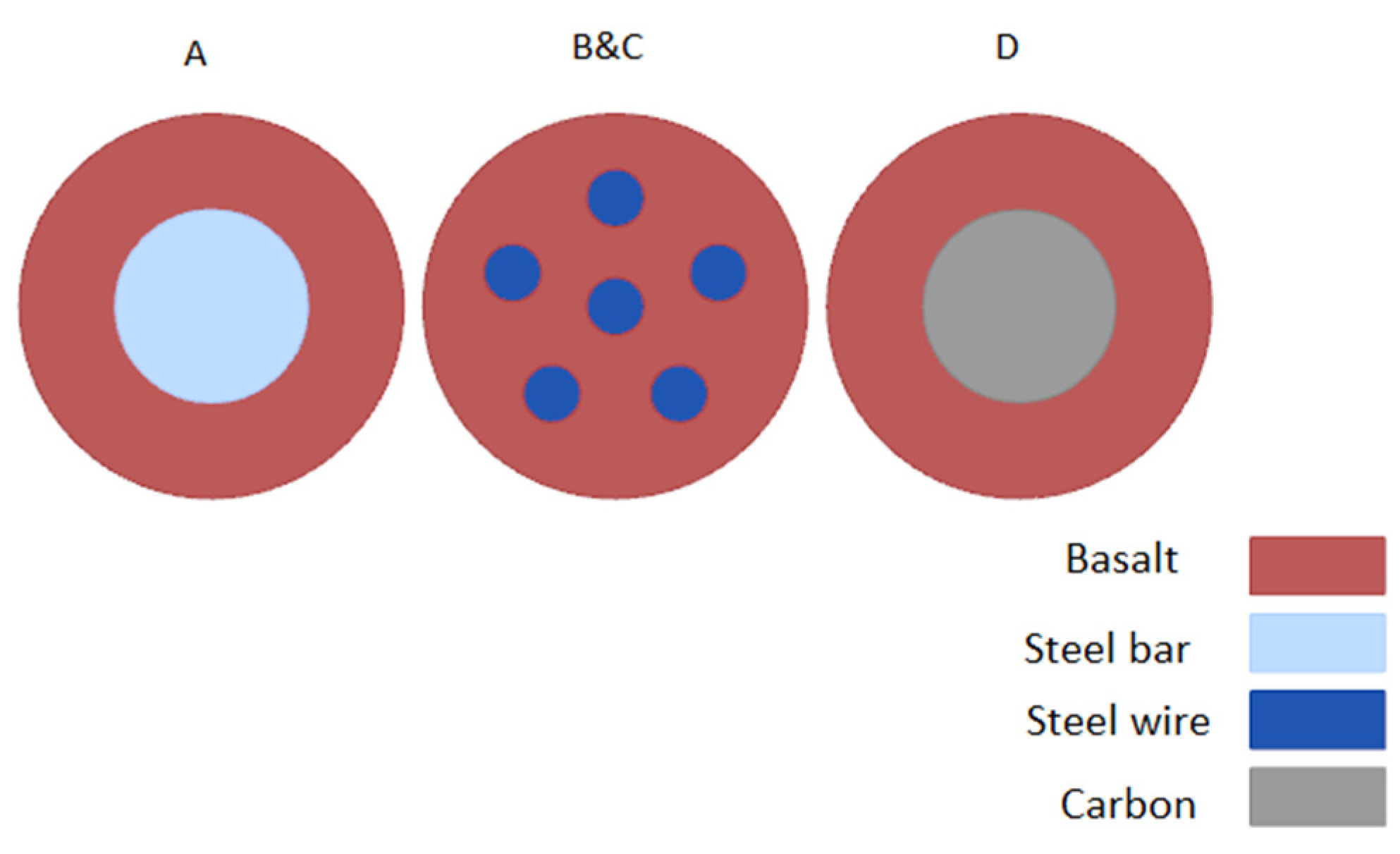
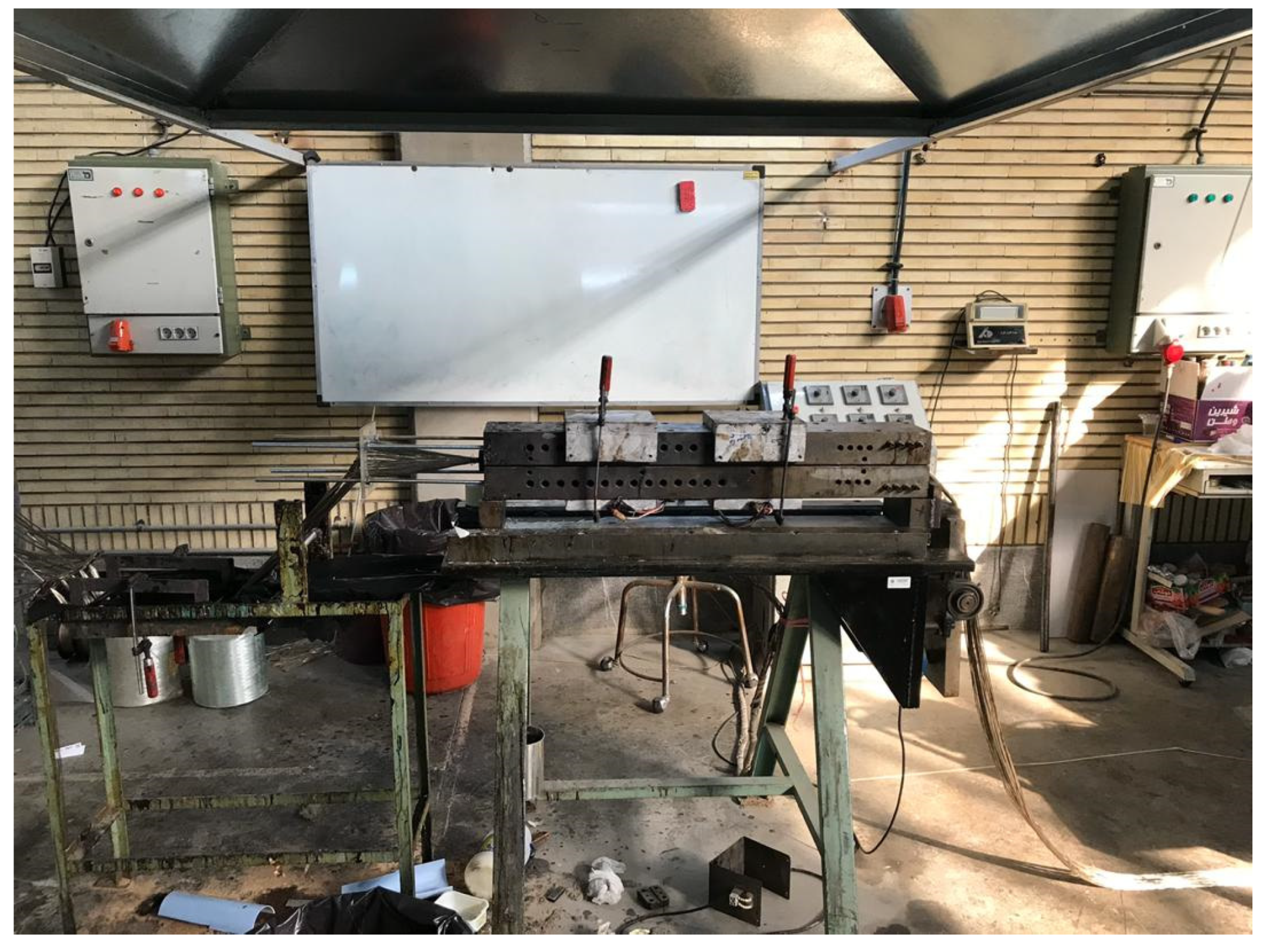
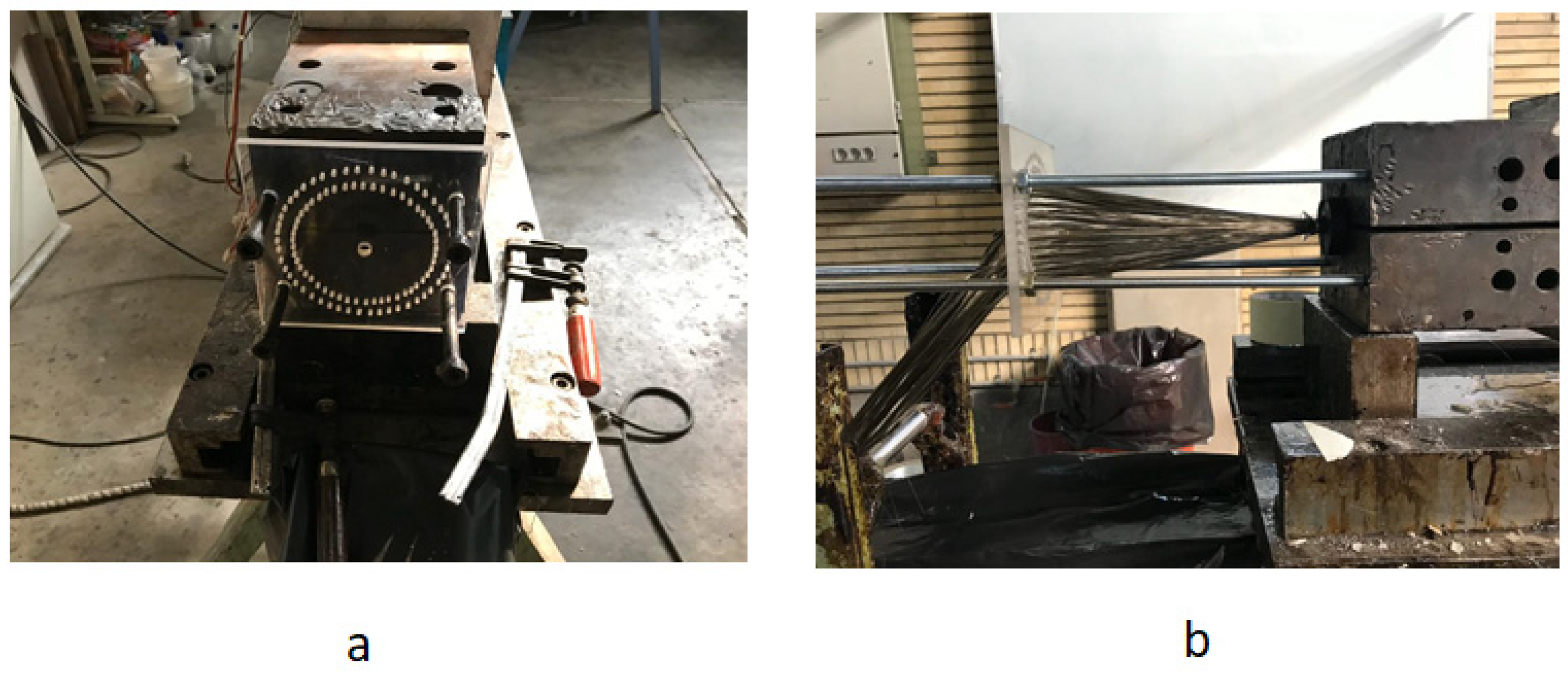
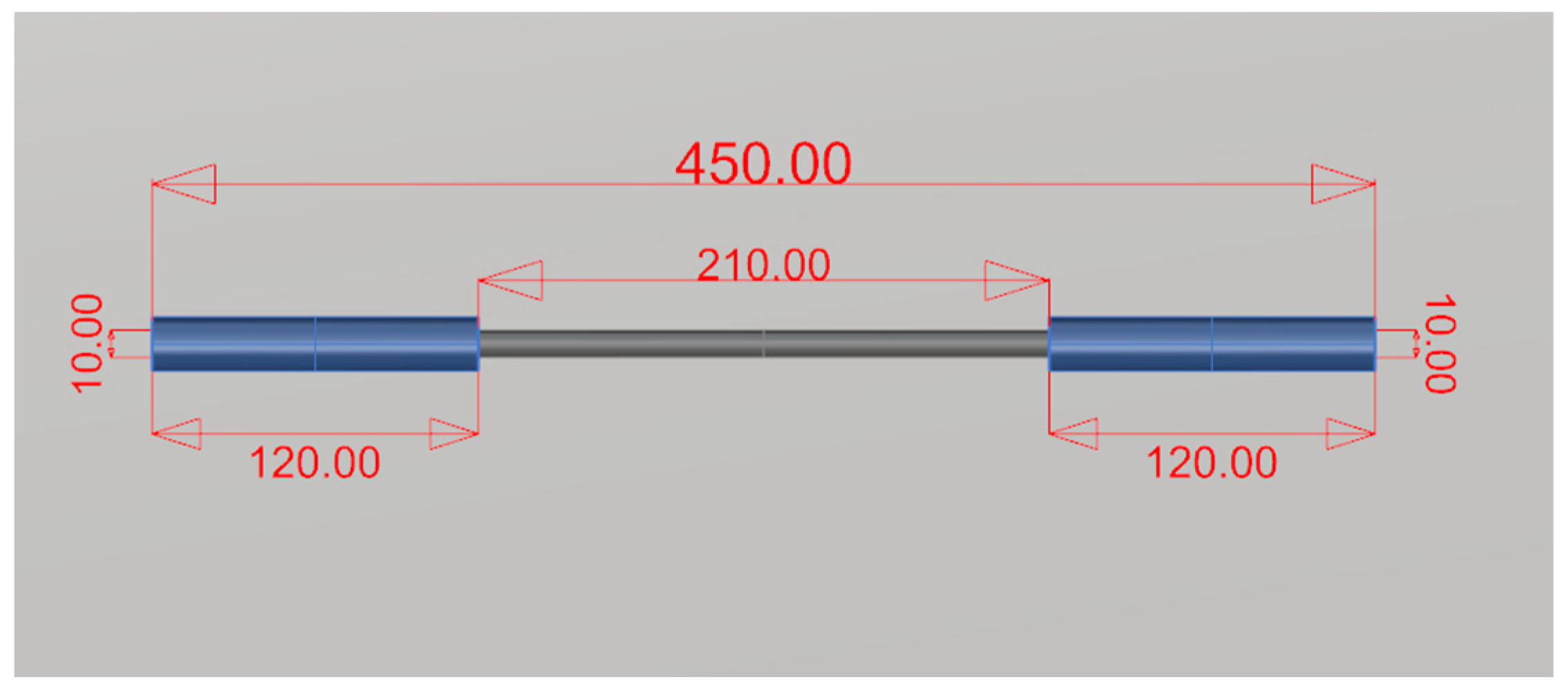

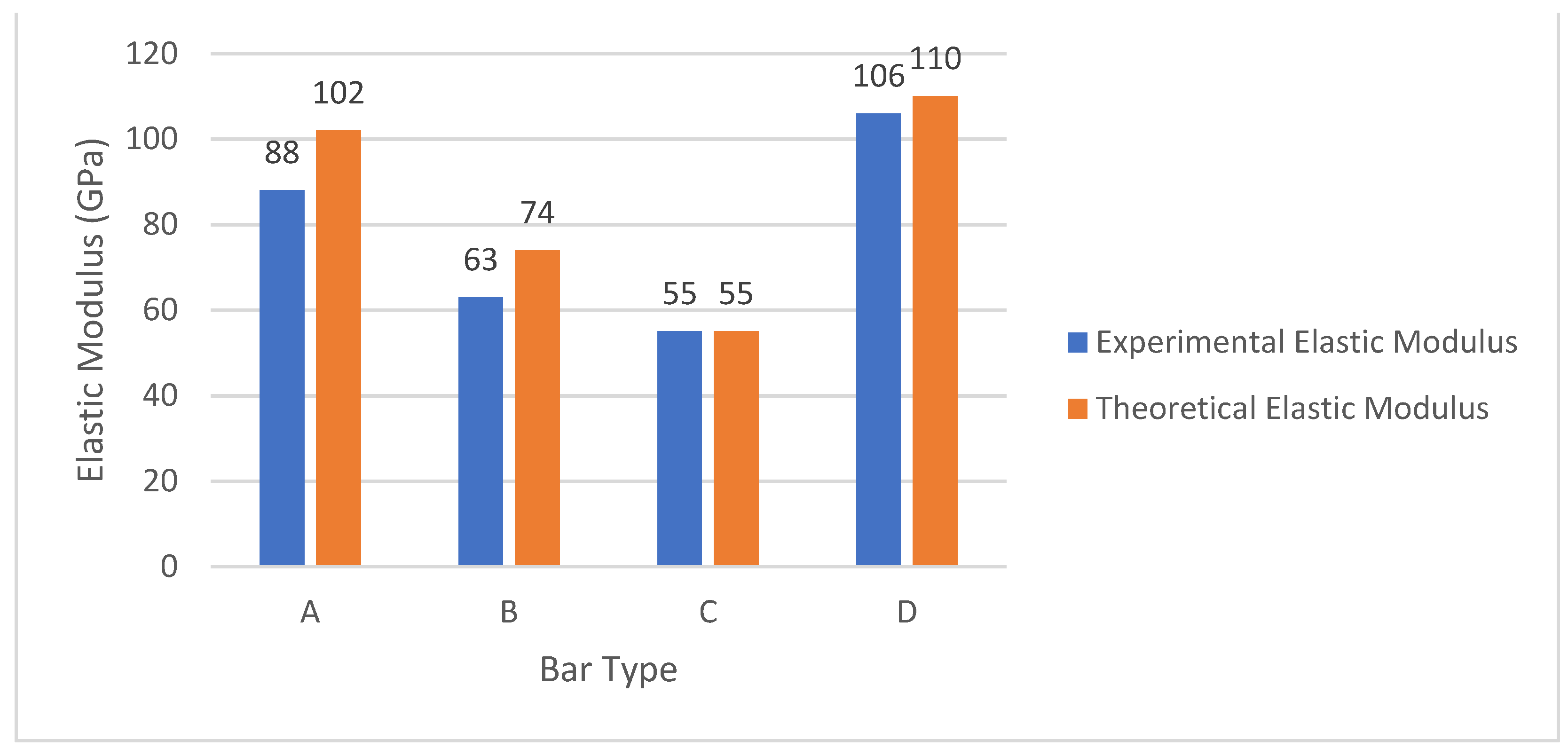

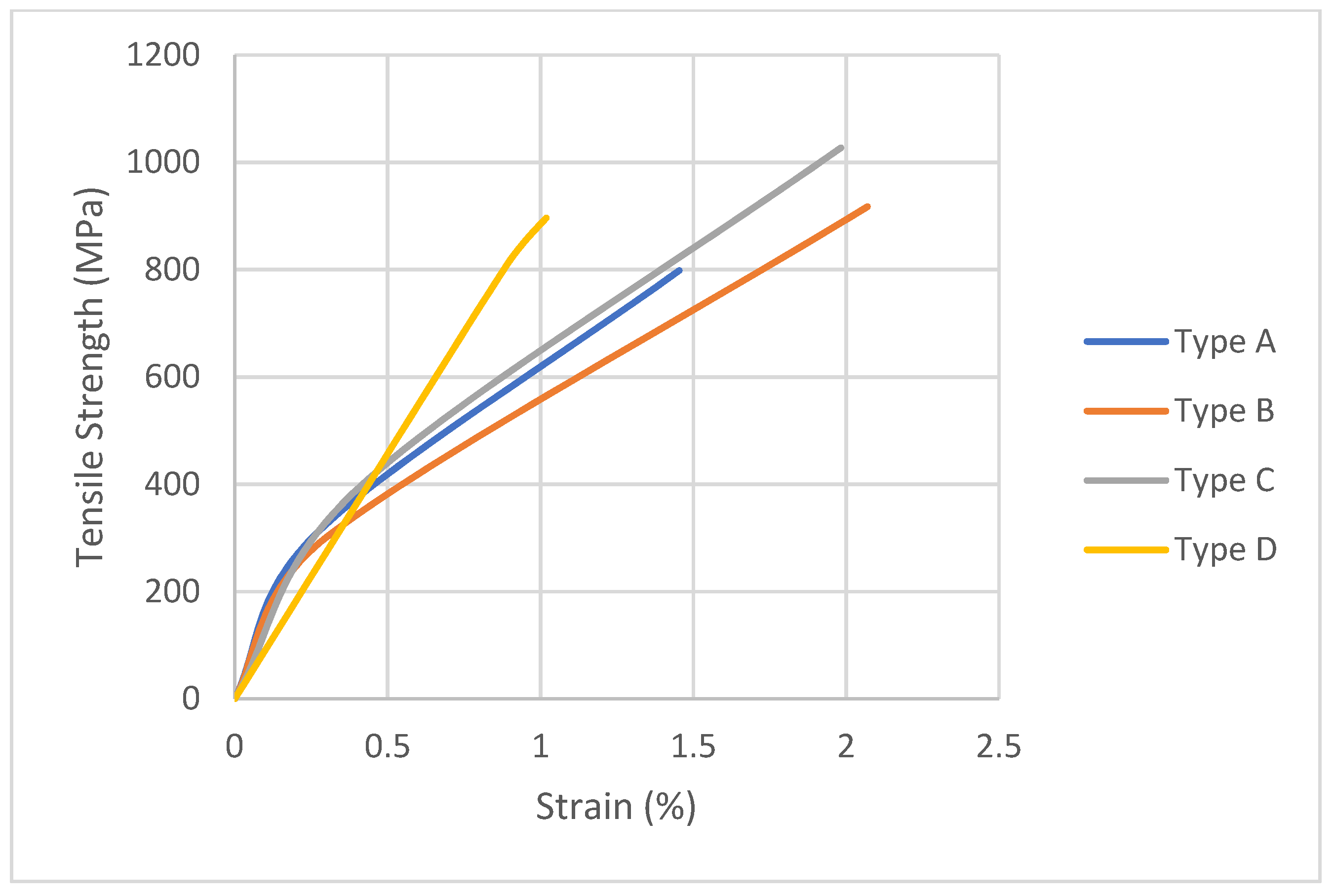


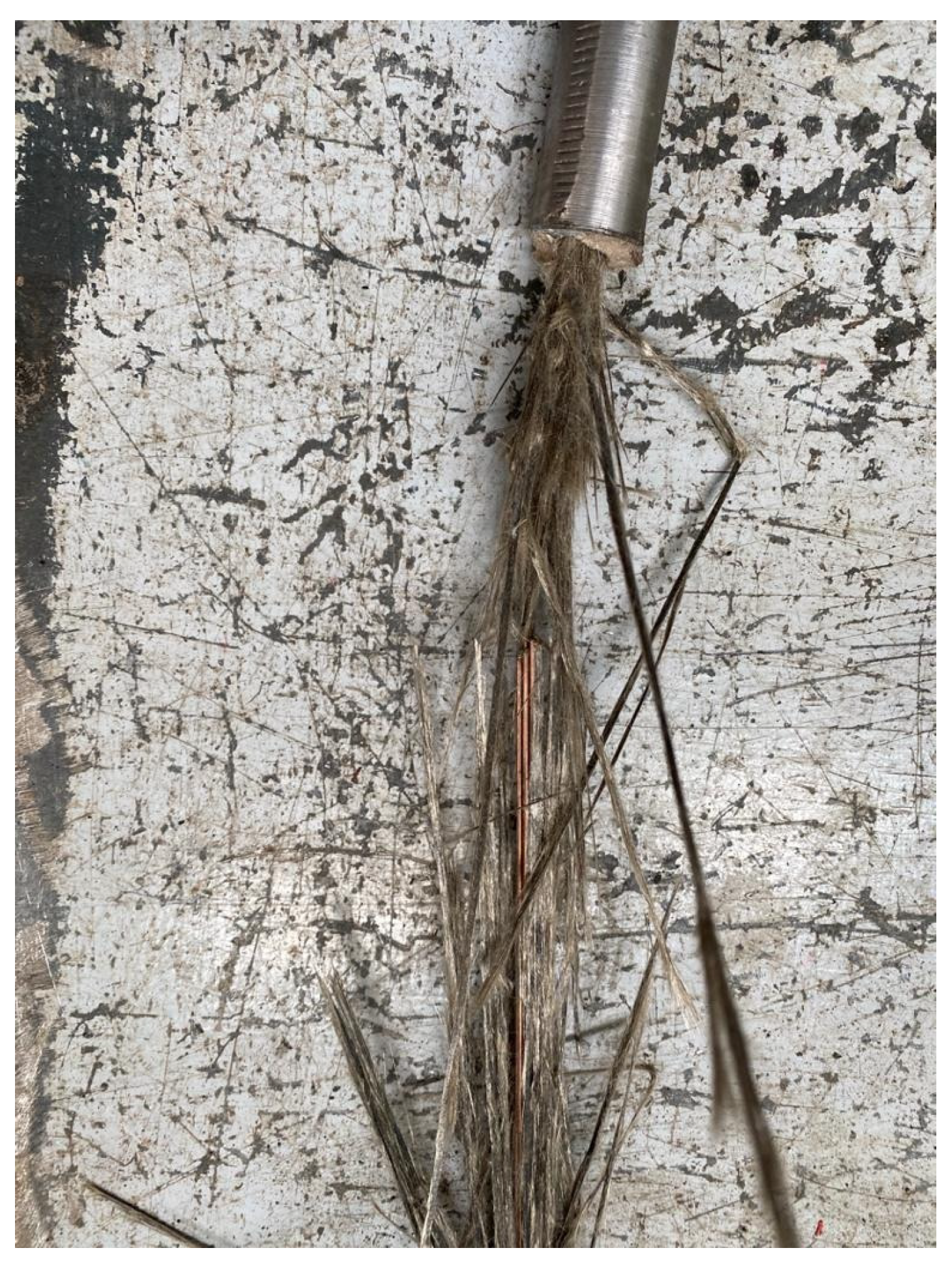
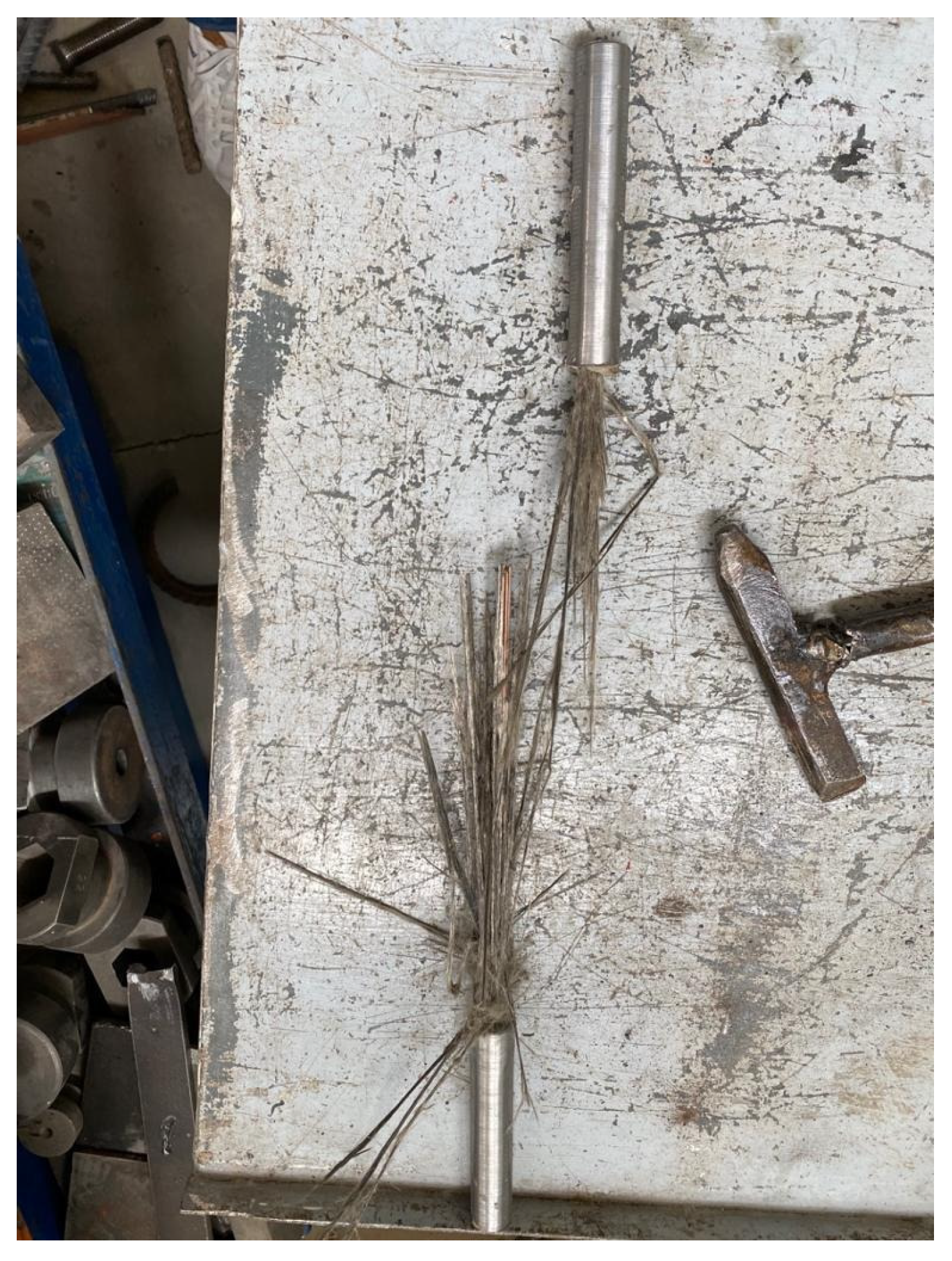
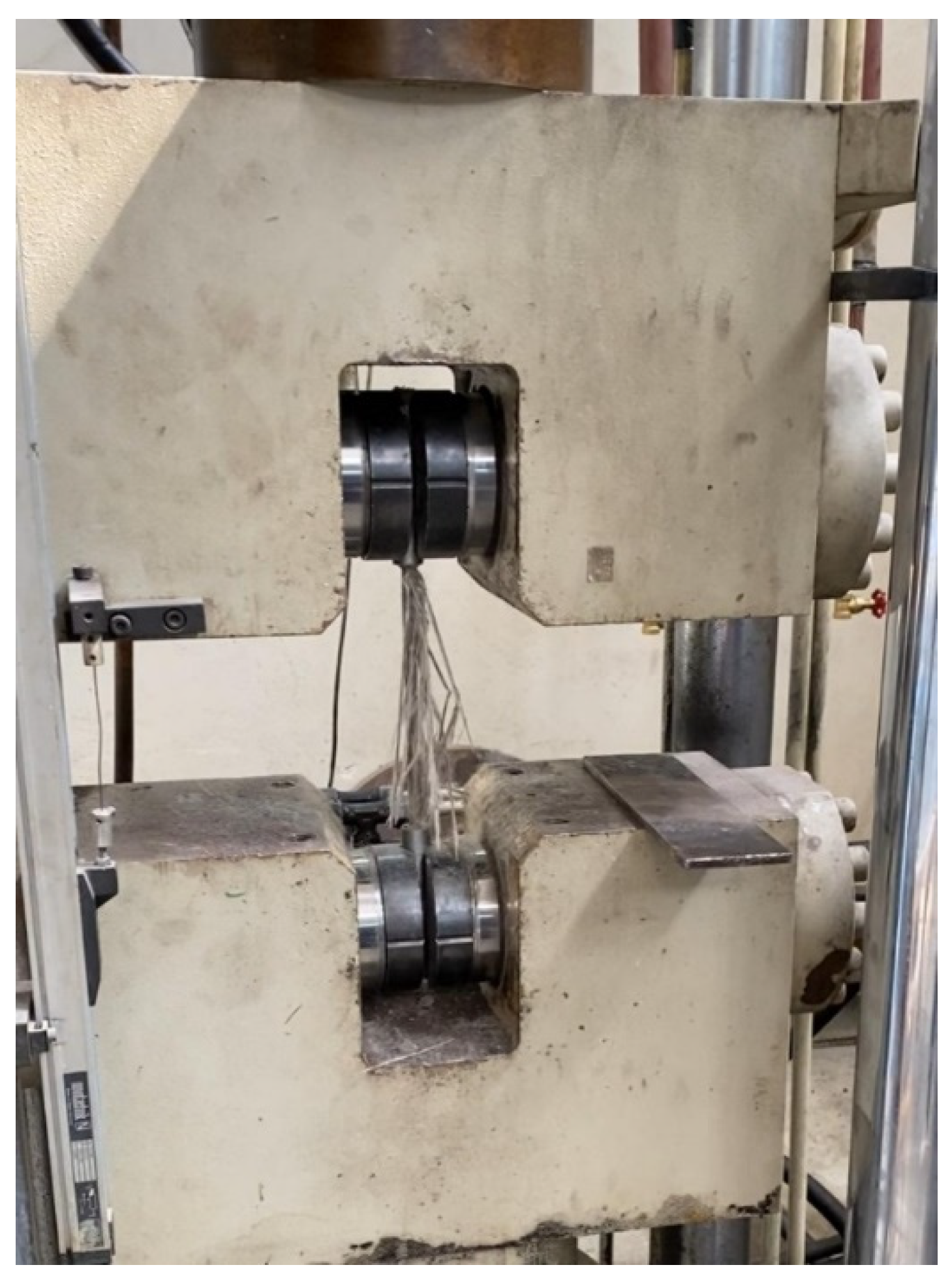
| Materials | Tensile Strength (MPa) | Elastic Modulus (GPa) | Tensile Elongation (%) |
|---|---|---|---|
| Carbon T300 fibers | 1230–1540 | 225 | 1.25–1.5 |
| Basalt fibers | 1050–1100 | 72 | 2.8–3 |
| Steel wires | 1270–1470 | 200 | 20 |
| Steel bar | 400 | 200 | 20 |
| Vinyl ester 901 | 75 | 3 | 4.5–5 |
| Bar Types | Diameter (mm) | Steel Cross-Section Area | Basalt Cross-Section Area | Carbon Cross-Section Area | Theoretical EH (GPa) |
|---|---|---|---|---|---|
| A | 10 | 36% | 64% | 0 | 102 |
| B | 10 | 22% | 78% | 0 | 74 |
| C | 10 | 22% | 78% | 0 | 55 |
| D | 10 | 0% | 70% | 30% | 114 |
| Types of Composite Hybrid Bar | Tensile Strength (MPa) | Experimental Elastic Modulus (GPa) | Theoretical Elastic Modulus (GPa) |
|---|---|---|---|
| A | 798.6 | 88 | 102 |
| B | 917.4 | 63 | 74 |
| C | 1027.3 | 55 | 55 |
| D | 869.7 | 106 | 110 |
| Types of Composite Hybrid Bar | Tensile Strength (MPa) | Experimental Elastic Modulus (GPa) | Improvement in Elastic Modulus (%) | Improvements in Tensile Strength (%) |
|---|---|---|---|---|
| A | 798.6 | 88 | 83.3 | −2.03 |
| B | 917.4 | 63 | 31.25 | 12.53 |
| C | 1027.3 | 55 | 14.58 | 26.01 |
| D | 869.7 | 106 | 120.83 | 6.68 |
| GFRP | 815.23 | 48 | − | − |
| Types of Composite Hybrid Bar | Mean Value for Energy Absorbed (J) |
|---|---|
| A | 30.45 |
| B | 62.33 |
| C | 72.03 |
| D | 25.97 |
Publisher’s Note: MDPI stays neutral with regard to jurisdictional claims in published maps and institutional affiliations. |
© 2021 by the authors. Licensee MDPI, Basel, Switzerland. This article is an open access article distributed under the terms and conditions of the Creative Commons Attribution (CC BY) license (https://creativecommons.org/licenses/by/4.0/).
Share and Cite
Mirdarsoltany, M.; Rahai, A.; Hatami, F.; Homayoonmehr, R.; Abed, F. Investigating Tensile Behavior of Sustainable Basalt–Carbon, Basalt–Steel, and Basalt–Steel-Wire Hybrid Composite Bars. Sustainability 2021, 13, 10735. https://doi.org/10.3390/su131910735
Mirdarsoltany M, Rahai A, Hatami F, Homayoonmehr R, Abed F. Investigating Tensile Behavior of Sustainable Basalt–Carbon, Basalt–Steel, and Basalt–Steel-Wire Hybrid Composite Bars. Sustainability. 2021; 13(19):10735. https://doi.org/10.3390/su131910735
Chicago/Turabian StyleMirdarsoltany, Mohammadamin, Alireza Rahai, Farzad Hatami, Reza Homayoonmehr, and Farid Abed. 2021. "Investigating Tensile Behavior of Sustainable Basalt–Carbon, Basalt–Steel, and Basalt–Steel-Wire Hybrid Composite Bars" Sustainability 13, no. 19: 10735. https://doi.org/10.3390/su131910735
APA StyleMirdarsoltany, M., Rahai, A., Hatami, F., Homayoonmehr, R., & Abed, F. (2021). Investigating Tensile Behavior of Sustainable Basalt–Carbon, Basalt–Steel, and Basalt–Steel-Wire Hybrid Composite Bars. Sustainability, 13(19), 10735. https://doi.org/10.3390/su131910735







